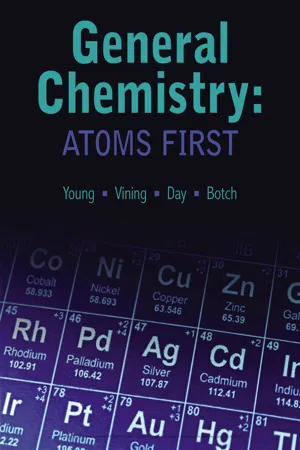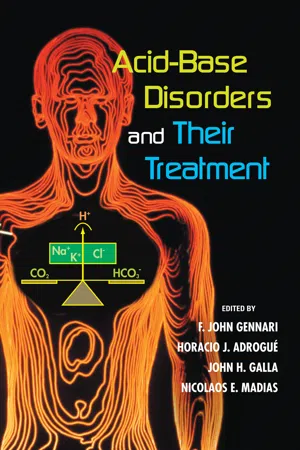Chemistry
Acid-Base Reactions and Buffers
Acid-base reactions involve the transfer of protons from an acid to a base. Buffers are solutions that resist changes in pH when an acid or base is added. They are composed of a weak acid and its conjugate base, or a weak base and its conjugate acid, and help maintain the stability of pH in various chemical systems.
Written by Perlego with AI-assistance
Related key terms
1 of 5
11 Key excerpts on "Acid-Base Reactions and Buffers"
- eBook - PDF
- Young, William Vining, Roberta Day, Beatrice Botch(Authors)
- 2017(Publication Date)
- Cengage Learning EMEA(Publisher)
AlbertSmirnov/iStockphoto.com 18 Advanced Acid–Base Equilibria Unit Outline 18.1 Acid–Base Reactions 18.2 Buffers 18.3 Acid–Base Titrations 18.4 Some Important Acid–Base Systems In This Unit We will now expand the introductory coverage of acid–base equilibria and explore the chemistry of more complicated aqueous solutions con-taining acids and bases. First, we will address the different types of acid–base reactions, and then we will move on to study buffer solutions, acid–base titrations, and polyprotic acids. One of the more important types of acid–base solutions in terms of commercial and biological appli-cations is buffers because they allow us to control the pH of a solution. So that you can get a feeling for the importance of buffers in your world, we will also briefly discuss the chemistry of two important buffers in bio-logical systems. In Precipitation and Lewis Acid–Base Equilibria (Unit 19) , we will conclude our coverage of chemical equilibria with Lewis acids and bases and the equilibria of sparingly soluble compounds. Copyright 2018 Cengage Learning. All Rights Reserved. May not be copied, scanned, or duplicated, in whole or in part. WCN 02-300 Unit 18 Advanced Acid–Base Equilibria 568 18.1 Acid–Base Reactions 18.1a Strong Acid/Strong Base Reactions In Chemical Reactions and Solution Stoichiometry (Unit 9) you learned that acids and bases react to form water and a salt and that these reactions are called neutralization reac-tions because, on completion of the reaction, the solution is neutral. However, acid–base reactions do not always result in the formation of a solution with a neutral pH, and not all acid–base reactions proceed to 100% completion (Interactive Figure 18.1.1). Interactive Figure 18.1.1 Investigate the extent of acid–base reactions. - eBook - PDF
- Krish Moorthy(Author)
- 2007(Publication Date)
- CRC Press(Publisher)
5 Acids, Bases, and Buffers In biochemistry, the most useful definition of an acid and a base is that of Brönsted. Acids are substances that donate hydrogen ions, and bases are substances that accept hydrogen ions. Table 5.1 lists some common inorganic, organic, and biochemical compounds that can ionise to give hydro-gen ions, and their corresponding conjugate bases. Hydrogen ions (H + ) exist in water as hydronium ion (H 3 O + ). H + + H 2 O → H 3 O + In simple terms, a hydrogen ion is the same as a proton. The terms H + , proton, and H 3 O + are generally interchangeable. The Brönsted definitions, particularly the concept of a conjugate base, do cause some confusion. Note in Table 5.1 that NH 4 + is denoted as an acid. We all know that NH 4 OH, like NaOH, is a base or an alkali (an alkali is an aqueous solution of a base). Similarly, -COOH is an acid group, whereas -NH 2 is a basic group. What about -NH 3 + ? Most of the difficulties can be resolved by considering: (a) the extent of dissociation or ionisation — it is this concept that introduces terms such as strong and weak acids and bases. (b) whether the equilibrium of an ionisation, or the reaction with water, is to the right or left. In the Brönsted definition, water is a base! H + + H 2 O → H 3 O + The most important practical definitions of all these electrolytes (the collective term for acids, bases, and salts) is what they do with respect to water. Water dissociates to a very small extent. H 2 O � H + + OH -or as chemists prefer it: H 2 O + H 2 O � H 3 O + + OH -The molar concentration of water is 55.5 mol/L and of H 3 O + and OH -is 10 -7 mol/L each. It is this feature that gives us the pH scale —the pH of water and neutral solutions is 7, acidic solutions have pH less than 7, and basic solutions have pH greater than 7. Acids then are substances that increase - eBook - PDF
Chemistry
An Atoms First Approach
- Steven Zumdahl, Susan Zumdahl, Donald J. DeCoste, , Steven Zumdahl, Steven Zumdahl, Susan Zumdahl, Donald J. DeCoste(Authors)
- 2020(Publication Date)
- Cengage Learning EMEA(Publisher)
CHAPTER 14 14.1 Solutions of Acids or Bases Containing a Common Ion Equilibrium Calculations 14.2 Buffered Solutions Buffering: How Does It Work? 14.3 Buffering Capacity 14.4 Titrations and pH Curves Strong Acid–Strong Base Titrations Titrations of Weak Acids with Strong Bases Calculation of K a Titrations of Weak Bases with Strong Acids 14.5 Acid–Base Indicators Acid–Base Equilibria Colored Scanning Electron Micrograph (SEM) of human blood, showing red and white cells and platelets. Blood has effective buffers to maintain the pH at a constant value. (SCIENCE PHOTO LIBRARY/Science Source) 578 Copyright 2021 Cengage Learning. All Rights Reserved. May not be copied, scanned, or duplicated, in whole or in part. Due to electronic rights, some third party content may be suppressed from the eBook and/or eChapter(s). Editorial review has deemed that any suppressed content does not materially affect the overall learning experience. Cengage Learning reserves the right to remove additional content at any time if subsequent rights restrictions require it. M uch important chemistry, including almost all the chemistry of the natural world, occurs in aqueous solution. We have already introduced one very significant class of aqueous reactions, those of acids and bases. In this chapter we will explore more applications of acid–base equilibria. In particular, we will examine buffered solutions, which contain components that enable the solution to be resistant to a change in pH. Buffered systems are especially impor- tant in living systems, which can survive only in a relatively narrow pH range. For example, although human blood contains many buffering systems, the most im- portant of these consists of a mixture of carbonic acid (,0.0012 M) and bicarbon- ate ion (,0.024 M). These concentrations produce a pH of 7.4 for normal blood. Because our cells are so sensitive to pH, it is important that this pH value be maintained. - eBook - PDF
- F. John Gennari, Horacio J. Adrogue, John H. Galla, Nicolaos Maddias, F. John Gennari, Horacio J. Adrogue, John H. Galla, Nicolaos Maddias(Authors)
- 2005(Publication Date)
- CRC Press(Publisher)
1 Acid–Base Chemistry and Buffering F. John Gennari University of Vermont College of Medicine, Burlington, Vermont, U.S.A. John H. Galla Department of Medicine, University of Cincinnati College of Medicine, Cincinnati, Ohio, U.S.A. INTRODUCTION Acid–base biochemistry encompasses the physical chemistry of the constitu-ents of biological solutions that influence the dissociation of, and therefore the concentration of, hydrogen ions (H þ ) in those solutions. In the biologi-cal solutions that comprise the body fluids, these constituents include elec-trolytes that are essentially completely dissociated at the solute strength that exists in the body fluids, termed ‘‘strong ions’’ (1,2), a wide variety of weak acids and, most importantly, the volatile weak acid H 2 CO 3 (carbonic acid). Central to an understanding of acid–base homeostasis is knowledge of the chemistry of weak acids and, in particular, carbonic acid. In this chapter, we review the physical chemistry that underlies acid–base homeostasis, incorporating the concepts of Brønsted and Lowry, who defined acids as H þ donors and bases as H þ acceptors (3,4). The additional role of strong ions, which are regulated independently of the dictates of acid–base home-ostasis but influence [H þ ] is discussed at the end of this chapter. Van Slyke (5) revolutionized our ability to approach and deal with the acid–base status of biological solutions, using the concepts of Brønsted and Lowry to focus on [H þ ] through evaluation of a single weak acid, H 2 CO 3 (carbonic acid). Stewart (1,2) added the constraints of electroneutrality to the assessment of [H þ ] and separated the quantities that can be manipulated 1 external to the solution, i.e., the concentrations of strong ions, buffer content, and PCO 2 , from the quantities that are dependent on the nature of the solution, i.e., [H þ ] and [HCO 3 ]. - eBook - PDF
- Charlotte W. Pratt, Kathleen Cornely(Authors)
- 2020(Publication Date)
- Wiley(Publisher)
2.3 Acid–Base Chemistry • The dissociation of water produces hydroxide ions (OH − ) and protons (H + ) whose concentration can be expressed as a pH value. The pH of a solution can be altered by adding an acid (which donates protons) or a base (which accepts protons). • The tendency for a proton to dissociate from an acid is expressed as a pK value. • The Henderson–Hasselbalch equation relates the pH of a solution of a weak acid and its conjugate base to the pK and the concentrations of the acid and base. 2.4 Tools and Techniques: Buffers • A buffered solution, which contains an acid and its conjugate base, resists changes in pH when more acid or base is added. 2.5 Clinical Connection: Acid–Base Balance in Humans • The body uses the bicarbonate buffer system to maintain a con- stant internal pH. Homeostatic adjustments are made by the lungs, where CO 2 is released, and by the kidneys, which excrete H + and ammonia. SUMMARY polarity hydrogen bond ionic interaction van der Waals radius electronegativity van der Waals interaction dipole–dipole interaction London dispersion forces dielectric constant solute solvation hydration KEY TERMS 46 CHAPTER 2 Aqueous Chemistry Brief Bioinformatics Exercises 2.1 Structure and Solubility 2.2 Amino Acids, Ionization, and pK Values BIOINFORMATICS 2.1 Water Molecules and Hydrogen Bonds 1. Each CO bond in CO 2 is polar, yet the whole molecule is nonpolar. Explain. 2. The HCH bond angle in the perfectly tetrahedral CH 4 molecule is 109º. Explain why the HO H bond angle in water is only about 104.5º. 3. Which compound has a higher boiling point, H 2 O or H 2 S? Explain. 4. Consider the following molecules and their melting points listed below. How can you account for the differences in melting points among these molecules of similar size? Molecular weight Melting (g · mol –1 ) point (°C) Water, H 2 O 18.0 0 Ammonia, NH 3 17.0 −77 Methane, CH 4 16.0 −182 5. - eBook - PDF
- Allan Blackman, Steven E. Bottle, Siegbert Schmid, Mauro Mocerino, Uta Wille(Authors)
- 2022(Publication Date)
- Wiley(Publisher)
Indeed, the Hungarian-born US chemist George Olah was awarded the Nobel Prize in chemistry in 1994 for his seminal work in the field of superacids, results of which found significant applications in the petrochemical industry. FIGURE 11.14 Representation of the structure of a carborane acid with the chemical formula H(CHB 11 Cl 11 ). The chlorine atoms are green, the boron atoms are pink, the carbon atom is black and the hydrogen atoms are white. 11.6 Buffer solutions LEARNING OBJECTIVE 11.6 Perform calculations involving buffer solutions. The control and maintenance of pH is crucial in many chemical and biological systems. For example, if the pH of your blood, which is typically 7.35 to 7.42, were to change to either 7.00 or 8.00, you would die. Fortunately, nature has developed a sophisticated chemical system, called a buffer, which maintains blood pH within the vital limits. Figure 11.15 shows another application of a buffer. A buffer solution is one that contains appreciable amounts of both a weak acid and its conjugate base, or a weak base and its conjugate acid. As a result of this, a buffer solution resists change in pH after the addition of small amounts of either acid or base, and also on moderate dilution. The pH values over which a buffer is effective at maintaining the pH are determined by either the pK a or pK b of the weak acid or weak base, respectively, and the ratio of the concentrations of conjugate pairs present in the solution. pH calculations in buffer solutions We will first consider an aqueous buffer solution containing equal amounts of a weak acid HA and its conjugate base A - . A buffer solution works by being able to react to neutralise added H 3 O + or OH - . 536 Chemistry FIGURE 11.15 A practical application of a buffer. Baking soda, which is sodium bicarbonate, is sometimes added to swimming pools to control the pH of the water. If we add a source of H 3 O + to the above solution, it will react with A - to form HA. - Henry Freiser, Monika Freiser(Authors)
- 1992(Publication Date)
- CRC Press(Publisher)
Chapter 4 Acid Base Equi l i brium THEORIES OF ACIDS AND BASES Of the many theories that have been proposed through the years to explain the properties of acids and bases, the Bf0nsted-Lowry, or proton transfer theory, and the older, more general Lewis theory are most generally useful. The Br0nsted-lowry Theory In 1923 Bf0nsted and Lowry each developed an acid-base theory based on the central role of the proton. They defined an acid as a proton donor and a base as a proton acceptor. Thus, an acid-base reaction is one in which proton transfer occurs, Le., Acid ' Base + H + (4-1) According to this definition, neutral molecules such as H 3 P04 or H 2 0, cations such as NH / , and anions like H 2 P0 4 -all behave as acids, e.g., (4-2) Similarly, cations (H 2 NCH 2 CH 2 NH 3 + ) , anions (HC 2 0 4 -), and neutral mole-cules can all act as bases. Certain substances such as H 2 0 and SH-behave as acids as well as bases, and are called ampholytes or amphiprotic substances. SR ' H + + S = acid base H + + SH-' H 2 S base acid Equation 4-2 is a simplification of the proton transfer reaction that takes place if the reaction is carried out in a solvent such as water. Free protons 53 54 Concepts & Calculations in Analytical Chemistry do not exist in any solvent. The characterization of a substance as an acid or a base must be made in terms relative to the solvent, i.e. water. That is to say, an acid is a substance capable of donating a proton to water, and a base is a substance capable of accepting a proton from water. Reaction 4-2 is therefore more correctly represented as follows: (4-3) The hydrated proton is represented as H 3 0 + . Although it is, strictly speaking, incorrect to write H + to represent a hydrated proton, this is generally accepted for the sake of convenience. Throughout this book, H + and H 3 0 + will be used interchangeably. It is evident from Equation 4-3 that there is a proton transfer from the acid, NH4 + , to the water molecule, H 2 0.- Peter V. Hobbs(Author)
- 2000(Publication Date)
- Cambridge University Press(Publisher)
5 Acids and bases Very early in the history of chemistry many substances were designated as acids, bases, and salts. Acids have a sour taste (e.g., citric acid gives lemon juice its sour taste); they dissolve certain metals; and they also dissolve carbonate minerals to produce carbon dioxide. Bases have a bitter taste (e.g., sodium carbonate); they feel slippery when touched; and they react with many dissolved metal salts to form precipitates. However, the most striking characteristic of bases is their ability to neutralize the properties of acids; when a base reacts with an acid a salt is produced. The French chemist Lavoisier thought that all acids contain oxygen (the word oxygen means acid former in Greek). However, it was sub-sequently found that many acids contain no oxygen (e.g., hydrochloric acid, HC1), but that they all contain hydrogen. Acids and bases figure prominently in the equilibrium of aqueous solu-tions, where they significantly enhance the electrical conductivity of water. In this chapter, we will explore some of the important properties of acids and bases in aqueous solutions. This will lead us to a discussion of several theories of acids and bases. 5.1 Some definitions and concepts Equation (4.22) is valid for aqueous solutions as well as for pure water. A solution for which [H + (aq)] = [OH~(aq)] is said to be neutral; thus, pure water is neutral. If [H + (aq)] > [OH~(aq)] the solution is said to be acidic. If [OH(aq)] > [H + (aq)] the solution is said to be basic. Exercise 5.1. If 0.02 mole of hydrochloric acid is dissolved in 1L 1 of water, what are the concentrations of H + (aq) and OH(aq) ions I in the solution at 25°C? I 83 84 Acids and bases Solution. Hydrochloric acid is a gas under normal conditions, but it is a strong electrolyte that dissolves in water to form equal numbers of H + (aq) and Q(aq).- eBook - PDF
- Gary D. Christian, Purnendu K. Dasgupta, Kevin A. Schug(Authors)
- 2020(Publication Date)
- Wiley(Publisher)
A number, partic- ularly specific enzyme reactions that might be used for analyses (see Chapter 23), may occur in the pH range of 4 to 10 or even outside of this. The proper selection of buffers Pdf _Folio:2 47 248 CHAPTER 6 ACID–BASE EQUILIBRIA for the study of biological reactions or for use in clinical analyses can be critical in determining whether or not they influence the reaction. A buffer must have the correct pK a , near physiological pH so the ratio of [A - ]∕[HA] in the Henderson–Hasselbalch equation is not too far from unity, and it must be physiologically compatible. Phosphate Buffers One useful series of buffers are phosphate buffers. Biological systems usually con- tain some phosphate already, and phosphate buffers will not interfere in many cases. By choosing appropriate mixtures of H 3 PO 4 ∕H 2 PO 4 - , H 2 PO 4 - ∕HPO 4 2- , or HPO 4 2- ∕PO 4 3- , solutions over a wide pH range can be prepared. See G. D. Christian and W. C. Purdy, J. Electroanal. Chem., 3 (1962) 363 for the compositions of a series of phosphate buffers at a constant ionic strength of 0.2. Ionic strength is a mea- sure of the total salt content of a solution (see Chapter 5), and it frequently influences reactions, particularly in kinetic studies. Hence, these buffers could be used in cases where the ionic strength must be constant. However, the buffering capacity decreases markedly as the pH approaches the values for the single salts listed, and the single salts are not buffers at all. The best buffering capacity, obtained at the half neutralization points, is within ±1pH unit of the respective pK a values, that is, 1.96 ± 1, 7.12 ± 1, and 12.32 ± 1. Example 6.24 What weights of NaH 2 PO 4 and Na 2 HPO 4 would be required to prepare 1 L of a buffer solution of pH 7.45 that has an ionic strength of 0.100? Solution Let x = [Na 2 HPO 4 ] and y = [NaH 2 PO 4 ]. There are two unknowns, and two equations are needed. - eBook - PDF
General, Organic, and Biological Chemistry
An Integrated Approach
- Kenneth W. Raymond(Author)
- 2012(Publication Date)
- Wiley(Publisher)
To explain, let us use a different approach to describe what happens when hydroxide ion is added to this buffer: The reaction of OH - with H 3 O + reduces the concentration of each. H 3 O + + OH - ¡ 2H 2 O This causes a slowing of the reverse reaction between CH 3 CO 2 - and H 3 O + , which allows the forward reaction to predominate until equilibrium is reestablished. As a result, lost H 3 O + will be mostly replaced and the pH will remain fairly constant. CH 3 CO 2 H + H 2 O ¡ CH 3 CO 2 - + H 3 O + Interestingly, when the two reactions directly above are added together, and when reac- tants and products appearing unchanged on each side of the reaction arrow are removed, the resulting reaction equation is identical to the one at the beginning of this paragraph. H 3 O + + OH - ¡ 2 H 2 O CH 3 CO 2 H + H 2 O ¡ CH 3 CO 2 - + H 3 O + CH 3 CO 2 H + OH - ¡ CH 3 CO 2 - + H 2 O Regardless of which approach is used to explain the effect of adding OH - to this buffer, the result is the same. There is a net conversion of CH 3 CO 2 H into CH 3 CO 2 - and the pH remains constant. Buffers are most resistant to pH changes when the pH equals the pK a of the weak acid and are effective when the pH is within one unit of the pK a (pH = pK a ; 1). The pK a of acetic acid is 4.74, so an acetic acid and acetate ion buffer functions well over the pH range 3.74 to 5.74 and is most effective at a pH of 4.74. ■ Buffers resist changes in pH. 262 CHAPTER 7 Acids, Bases, and Equilibrium We have seen that a buffer can be prepared from a weak acid and its conjugate base, and that the concentration of these two substances is connected to the pH of the solution and the pK a of the acid (Table 7.6). Taking a more mathematical approach to these concepts allows us to more accurately describe the makeup of a buffer. - eBook - PDF
Introductory Chemistry
An Active Learning Approach
- Mark Cracolice, Edward Peters, Mark Cracolice(Authors)
- 2020(Publication Date)
- Cengage Learning EMEA(Publisher)
1. An acid–base reaction is a transfer of protons; a redox reaction is a transfer of electrons. 2. In both cases, the reactants are given special names to indicate their roles in the transfer process. An acid is a proton source; a base is a proton remover. A reducing agent is an electron source; an oxidizing agent is an electron remover. 3. Just as certain species can either provide or remove protons (e.g., HCO 3 2 and H 2 O) and thereby behave as an acid in one reaction and a base in another, certain species can either remove or provide electrons, acting as an oxidizing agent in one reaction and a reducing agent in another. An example is the Fe 21 ion, which can oxidize Zn atoms to Zn 21 in the reaction Fe 21 saqd 1 Znssd S Zn 21 saqd 1 Fessd Fe 21 can also reduce Cl 2 molecules to Cl 2 ions in another reaction: 2 Fe 21 saqd 1 Cl 2 sgd S 2 Cl 2 saqd 1 2 Fe 31 saqd 4. Just as acids and bases may be classified as stronger or weaker depending on how readily they remove or provide protons, the relative strengths of oxidizing and reducing agents may be compared according to their tendencies to attract or release electrons. 5. Just as most acid–base reactions in solution reach a state of equilibrium, most aqueous redox reactions also reach equilibrium. Just as the favored side of an acid–base equilibrium equation can be predicted from acid–base strength, the favored side of a redox equilibrium equation also can be predicted from oxidizing agent–reducing agent strength. 17.9 The Water Equilibrium Goal 12 Given the hydrogen ion or hydroxide ion concentration of water or a water solution, calculate the other value. In the remaining sections of this chapter, you will be multiplying and dividing expo- nentials, taking the square root of an exponential, and working with logarithms. We will furnish brief comments on these operations as we come to them. For more detailed instructions, see Appendix I, Parts A and C.
Index pages curate the most relevant extracts from our library of academic textbooks. They’ve been created using an in-house natural language model (NLM), each adding context and meaning to key research topics.










